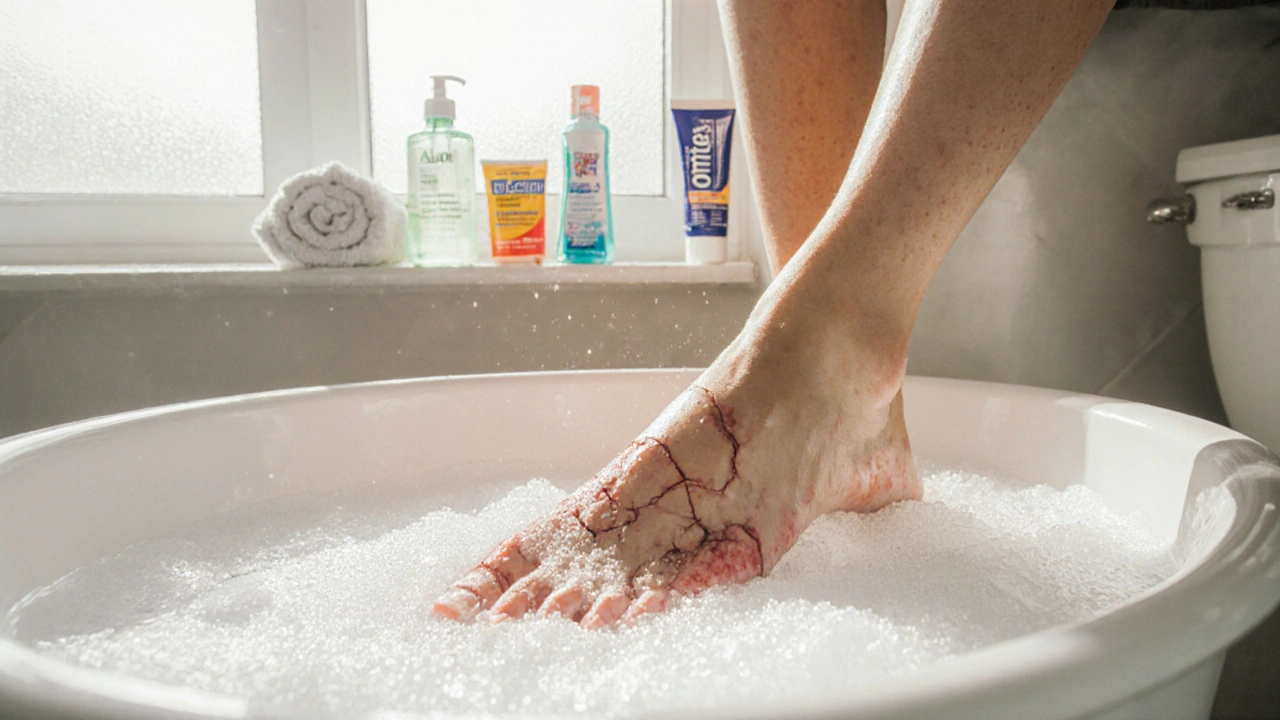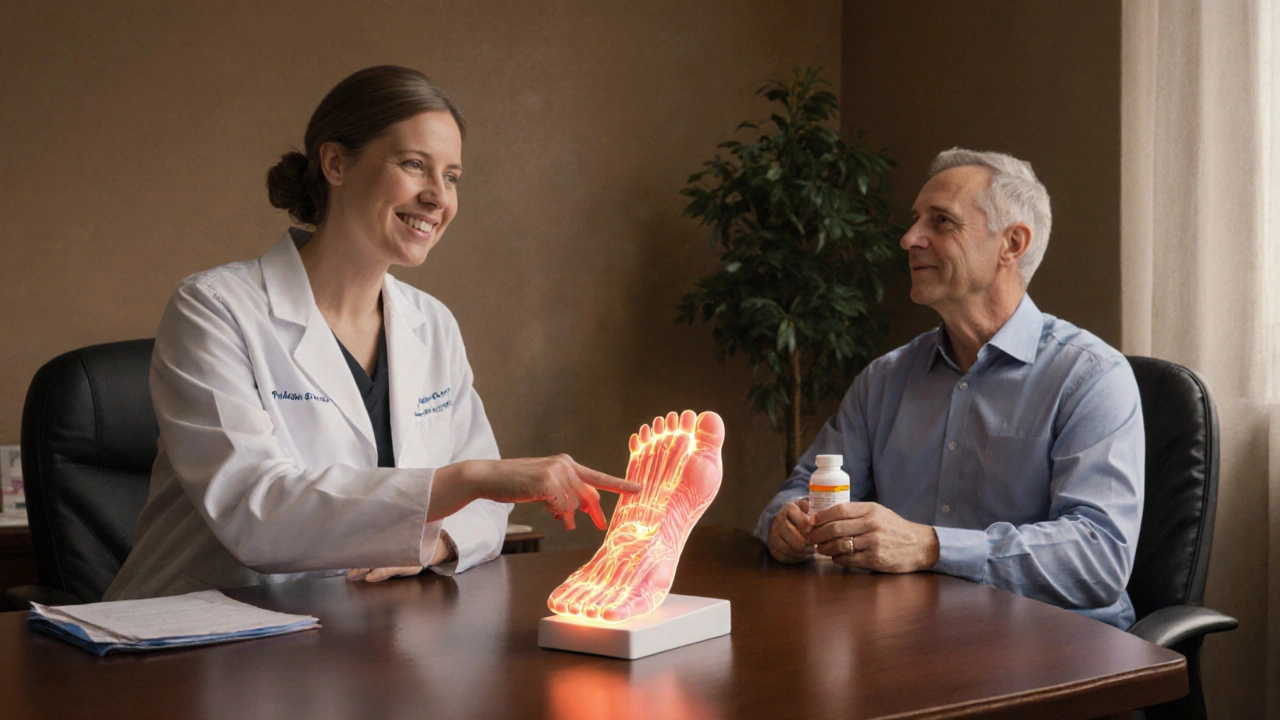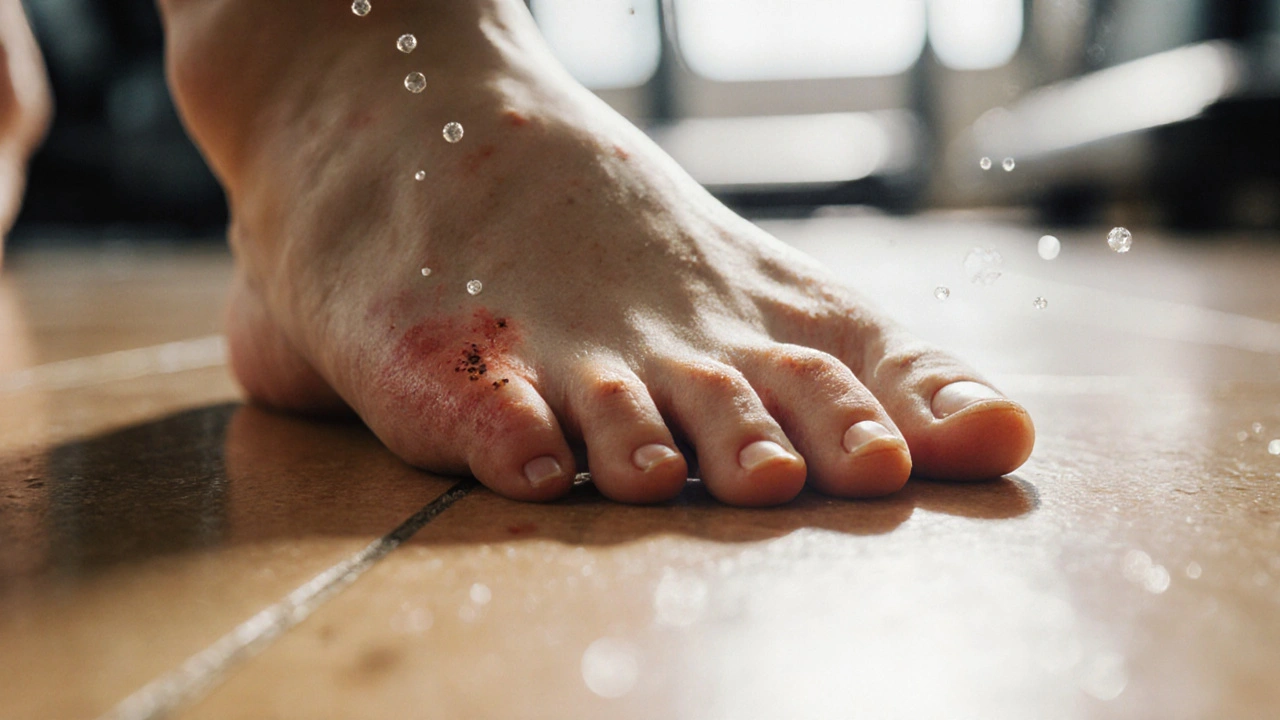Did you know that nearly one in six people will experience athlete's foot at some point in their lives? The itch, the cracking, the embarrassment-it's more common than many realize, and the good news is that it's usually easy to clear up.
Quick Facts
- Caused by dermatophyte fungi that thrive in warm, damp environments.
- Typical signs include itching, redness, and peeling between the toes.
- Over-the-counter antifungal creams work for most mild cases.
- Prescription oral meds are needed for severe or recurring infections.
- Keeping feet dry and choosing breathable footwear stops most reinfections.
When your feet start to itch, the culprit is often Athlete's foot a fungal infection of the skin on the feet, medically called tinea pedis. It’s not a sign of poor hygiene; it’s a fungus that loves moisture and warm skin.
What Causes the Itch?
The main perpetrators are dermatophyte fungi a group of molds, especially Trichophyton rubrum and Trichophyton interdigitale, that feed on keratin in skin, nails and hair. They spread through direct contact with contaminated surfaces-think locker-room floors, communal showers, or a soggy pair of socks.
Moisture the presence of water or sweat that softens skin and encourages fungal growth is their best friend. When feet stay damp for hours, the skin softens, making it easier for the fungus to invade. That's why sweaty gym sessions, hiking in rain, or wearing non-breathable shoes increase the risk.
Spotting the Signs
Typical symptoms appear within a few days to a couple of weeks after exposure:
- Intense itching, especially between the toes.
- Redness and a burning sensation.
- Peeling, cracking, or scaling skin that may look white or slightly yellow.
- In some cases, a faint, unpleasant odor.
- If the infection spreads to the soles or nails, you might notice thickened, discolored nails.
How Doctors Confirm It
Most clinicians recognize athlete's foot by visual inspection alone. A quick skin scraping examined under a microscope can reveal the fungal hyphae, confirming the diagnosis. In rare stubborn cases, a culture is sent to the lab to identify the exact species.

Treatment Options: From Shelves to Scripts
For mild to moderate cases, an antifungal cream topical medication that kills the fungus on the skin surface applied twice daily for two to four weeks does the trick. The most common active ingredients are clotrimazole, miconazole, and terbinafine.
Clotrimazole an over-the-counter azole antifungal that blocks the fungus’s cell membrane comes in 1% creams and sprays. It’s inexpensive and works well for most first-time infections.
If the infection spreads beyond the toe webs or recurs, a doctor may prescribe oral medication. Terbinafine a systemic antifungal taken as a short course, typically 250mg daily for two to six weeks has a higher cure rate for stubborn cases.
For those who dislike creams, powders or sprays containing tolnaftate offer a dry-feel alternative that also helps keep the area moisture-free.
Remember, the key to a quick recovery is consistency. Skipping applications or stopping treatment early lets the fungus rebound.
For fast relief, choose an effective Athlete's foot treatment that matches your needs.
Top Over-the-Counter Antifungal Creams
| Product | Active Ingredient | Typical Treatment Duration | Price (UK) | Pros | Cons |
|---|---|---|---|---|---|
| Canesten Cream | Clotrimazole 1% | 2-4 weeks | £4-£6 | Widely available, inexpensive | May need prolonged use for severe cases |
| Lamisil Cream | Terbinafine 1% | 1-2 weeks | £7-£9 | Fast-acting, high cure rate | Higher price |
| Micatin Spray | Miconazole nitrate 2% | 2-3 weeks | £5-£7 | Easy spray application | Can feel sticky |
| Scholl Antifungal Powder | Tolnaftate 1% | 2-4 weeks | £3-£5 | Keeps foot dry, good for sweaty feet | Less effective on thick skin |
Preventing Recurrence
Good foot hygiene regular cleaning, thorough drying, and proper nail care that reduces fungal growth is the backbone of prevention.
Simple steps:
- Wash feet daily with mild soap.
- Dry especially between toes-use a separate towel.
- Change socks at least once a day, preferably to a cotton or wool blend that wicks moisture.
- Rotate shoes; give them 24hours to air out.
- Choose breathable footwear-leather or mesh over plastic.
- Apply a powder or antifungal spray on the inside of shoes if you tend to sweat.
If you frequent communal areas, wear flip-flops or shower shoes to avoid direct contact with the floor.
When to Seek Professional Help
If you notice any of these red flags, book an appointment:
- Symptoms persist after four weeks of OTC treatment.
- Severe pain, swelling, or pus.
- Signs of infection spreading to the nails or soles.
- Diabetes, compromised immune system, or poor circulation.
A healthcare provider can run a culture, prescribe oral medication, or suggest stronger topical solutions.

Frequently Asked Questions
Can athlete's foot spread to other parts of the body?
Yes. The same fungus can move to the groin (tinea cruris) or the body (tinea corporis) if the infection is left untreated.
Is it safe to use the same antifungal cream on both feet and hands?
Generally, yes. The cream targets the fungus, not the body part. Just make sure to wash your hands after applying.
How long does it take for nails to look normal after treatment?
Nail growth is slow-about 1mm per month. Full clearance can take 6-12months even after the fungus is gone.
Can natural remedies like tea tree oil work?
Tea tree oil has antifungal properties, but evidence is mixed. It may help mild cases, yet it shouldn't replace proven OTC or prescription meds.
Should I wear sandals while treating athlete's foot?
Open footwear lets the area breathe and dries faster, but be careful in public places to avoid re-contamination. Switch between sandals and breathable socks as needed.

Maribeth Cory
September 28, 2025 AT 05:35Hey everyone, great info here! If you keep your socks dry and rotate your shoes, the fungus doesn’t stand a chance. A quick spritz of powder after you shower can seal the deal. Remember, consistency is key - don’t quit halfway through the course.
andrea mascarenas
October 5, 2025 AT 04:15Thanks for the rundown. The steps are clear and easy to follow.
Vince D
October 12, 2025 AT 02:55Honestly, I’ve had athlete’s foot twice and the OTC creams cleared it up fast.
Camille Ramsey
October 19, 2025 AT 01:35First off, it’s “athlete’s foot,” not “athletes foot.” Also, “its” vs “it’s” matters – the article misspells a lot, which makes it look sloppy. Stop using “its” when you mean “it’s” and you’ll look smarter.
Scott Swanson
October 26, 2025 AT 00:15Wow, because we all love walking around with fungus, right? If you actually follow the simple tips, you’ll stop being a walking petri dish.
Karen Gizelle
November 1, 2025 AT 22:55It’s surprising how many people think ignoring basic foot hygiene is acceptable. We have a responsibility to ourselves and to anyone we share spaces with to keep our bodies clean. Neglecting those simple steps isn’t just lazy – it’s reckless. Let’s all do the right thing and treat our feet with respect.
Stephanie Watkins
November 8, 2025 AT 21:35I appreciate the clear bullet points. They make it easy to remember what to do each day.
Zachary Endres
November 15, 2025 AT 20:15You’ve got this, keep those feet dry!
Ashley Stauber
November 22, 2025 AT 18:55Honestly, I think the whole “fungus is bad” hype is overblown – our skin hosts microbes all the time.
Amy Elder
November 29, 2025 AT 17:35Nice summary, will try the powder on my next hike.
Erin Devlin
December 6, 2025 AT 16:15Fungus thrives where we create moisture; the solution lies in balance.